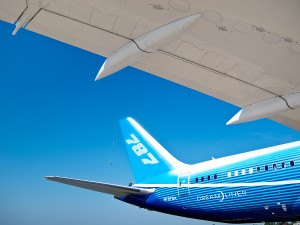U.K. regulators are still seeking the cause of last week’s fire on a Boeing Co. 787 parked at London’s Heathrow airport after saying they see no direct link to battery blazes that grounded the fleet earlier this year.
The Air Accidents Investigation Branch said in a July 13 statement that its probe probably will take several days and includes help from U.S. government agencies, Boeing and Ethiopian Airlines Enterprise, the plane’s operator.
 The fire renewed safety concerns about Boeing’s newest plane, sending the stock to its biggest drop in two years on July 12. The Chicago-based company is trying to restore confidence in the 787, which was grounded worldwide in January after lithium-ion batteries melted on two planes. Boeing may not necessarily have an easy fix just because the U.K. agency said it sees no direct link to the batteries in last week’s fire.
The fire renewed safety concerns about Boeing’s newest plane, sending the stock to its biggest drop in two years on July 12. The Chicago-based company is trying to restore confidence in the 787, which was grounded worldwide in January after lithium-ion batteries melted on two planes. Boeing may not necessarily have an easy fix just because the U.K. agency said it sees no direct link to the batteries in last week’s fire.
“I’m not sure it’s good news at all,” Robert Mann, an aviation consultant in Port Washington, New York, said in a telephone interview. He said investigators may find a new electrical malfunction while fixing the Ethiopian Airline’s 787’s hardened-plastic shell. It also will be tough repair because the heat damage is in a complex area where the fuselage joins the tail cone, which bears the load for the vertical fin.
“It’s not clear how you repair that,” Mann added. While fixing a traditional aluminum alloy fuselage is “relatively well understood, in composites, it’s not.” Other Dreamliner customers will be watching the incident closely, he said.
Boeing slid 4.7 percent to $101.87 on July 12 in New York, the biggest daily decline since Aug. 18, 2011. The shares rose 35 percent this year through last week, almost twice the 18 percent gain of the Standard & Poor’s 500 index.
Empty Plane
No one was on board the Ethiopian Airlines 787 at the time of the fire. The airline said it’s still flying its three other 787s while awaiting the results of the probe. Boeing, in an e- mailed statement, said it has a team on the ground at Heathrow and a spokesman declined to elaborate yesterday.
There is “no evidence of a direct causal relationship” to the batteries at this stage, the Air Accidents Investigation Branch said in a statement on its website July 13. Spokesmen for the U.K. agency didn’t respond to messages or e-mails yesterday.
In addition to Boeing and Ethiopian Airlines, the AAIB said it has invited the participation of the U.S. National Transportation Safety Board, the Federal Aviation Administration, and Ethiopian civil-aviation authorities. The U.K. Civil Aviation Authority and the European Aviation Safety Agency also were invited.
The Dreamliner, which had been parked for hours before the fire, sustained extensive heat damage in the upper portion of the rear fuselage and is being housed in a hangar at Heathrow, the AAIB said.
As Scheduled
Chicago-based United Continental Holdings Inc., the only U.S. carrier to fly the Dreamliner, and Japanese airline ANA Holdings Inc. said after the incident that they are operating their 787s as scheduled. Qantas Airways Ltd., Australia’s largest carrier, said its Jetstar budget airline had been briefed by Boeing on the initial investigation into the fire.
TUI Travel Plc’s charter arm Thomson Airways Ltd. said one of its 787s turned back to Manchester, England, on July 12 because of an unspecified fault after it left for Orlando Sanford International Airport in Florida. That same flight took off on schedule the next day, said John Greenway, an airport official in Manchester.
Through June, Boeing had delivered 66 Dreamliners to 11 airlines and a leasing company, including six to United Continental. The 787 has a list price of $206.8 million.
Prior Grounding
The FAA grounded the fleet on Jan. 16 after the lithium-ion batteries overheated on two aircraft, with one catching fire in Boston with no passengers aboard. In that incident, a Japan Airlines Co. 787 experienced what U.S. safety investigators called an uncontrolled chain reaction that charred the battery. The second malfunction occurred on an ANA Holdings plane that took off from Japan and was forced to make an emergency landing.
U.S. regulators cleared the Dreamliner to fly again in April after Boeing redesigned the battery to include more protection around individual cells to contain any overheating, a steel case to prevent fire and a tube to vent any vapors outside the fuselage. Ethiopian Airlines on April 27 made the first Dreamliner flight after the grounding was lifted, traveling from Addis Ababa to Nairobi. The carrier has four 787s.
Having the U.K. take the lead on the current investigation has the potential to help further restore confidence in the fleet, according to said Richard Aboulafia, an aerospace analyst with Teal Group, a Fairfax, Virginia-based consultant.
“Getting a foreign professional organization to look at the incident and clear the design would be a real plus,” he said.
(Editors: Kevin Miller, Kenneth Pringle)
Was this article valuable?
Here are more articles you may enjoy.

 What The Return of California’s ‘Death Discount’ Means for Litigation
What The Return of California’s ‘Death Discount’ Means for Litigation  Surging Oil Tanker Insurance Points to Growing Black Sea Chaos
Surging Oil Tanker Insurance Points to Growing Black Sea Chaos  NYC Sues Delivery App Over Lost Pay in New Mamdani Crackdown
NYC Sues Delivery App Over Lost Pay in New Mamdani Crackdown  California Governor Seeks $200M to Replace EV Tax Credits Cut by Trump
California Governor Seeks $200M to Replace EV Tax Credits Cut by Trump 